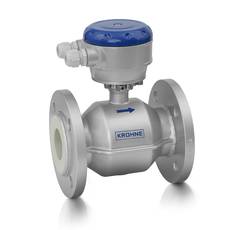Solution for the water and wastewater industry
- Engineered and manufactured for the water and wastewater industry
- Wide range of approvals for potable water
- Long-term reliability and negligible maintenance
The OPTIFLUX 2000 electromagnetic flow sensor is the optimum solution for water and wastewater applications.
The OPTIFLUX 2000 is designed to meet the demands for all water and waste water applications including groundwater, potable water, waste water, sludge and sewage, industry water and salt water.
The OPTIFLUX 2000 has a field proven and unsurpassed lifetime. This is assured by the fully welded construction, full bore pipe, absence of moving parts and wear resistant liner materials. The sensor has the widest diameter range available in the market: from DN25 up to DN3000.
Its long-term reliability and durability make it the standard flow sensor for the water industry for measuring abstraction water, drinking water, wastewater, sewage and effluent.
Highlights
- Drinking water approvals including KTW, WRc, KIWA, ACS
- Suitable for underground installation and constant flooding (IP 68)
- Bidirectional flow metering
- Compliant with requirements for custody transfer (MID MI-001, OIML R49,
- ISO 4064, EN 14154)
- Standard in house wet calibration of sensors up to diameter DN3000
- Easy installation and commissioning
- With virtual reference option grounding rings can be omitted and installation is simplified
- Rugged liners suitable for all water and wastewater applications
- In-situ verification with MagCheck
- Extensive diagnostic capabilities
- Maintenance-free
- Proven and unsurpassed lifetime
Industries
- Water
- Wastewater
- Pulp & Paper
- Minerals & Mining
- Iron, Steel & Metals
- Power
Applications
- Water abstraction
- Water purification and desalination
- Drinking water distribution networks
- Revenue metering or billing
- Leakage detection
- Irrigation
- Industry water
- Cooling water
- Wastewater
- Sewage and sludges
- Seawater
From standard to customized
For easy ordering the standard range of the OPTIFLUX 2000F covers all popular sizes, flange materials and connections (ASME, EN, JIS, AWWA). But KROHNE does not stop here. Our extensive engineering department is dedicated to provide solutions for all specifications not covered by our standard range. Requests for special sizes, flange connections, pressure ratings, building lengths, and materials, will always get a serious review. Whenever possible we will engineer a flow meter that fits your application.
Easy installation
Fitting the OPTIFLUX 2000 is easy with the flanged design and standard ISO insertion lengths. To further ease the operation, the OPTIFLUX 2000 can be installed without filters and straighteners. Even grounding rings are not required with the patented “Virtual Reference” option on the IFC 300 convert
Custody transfer
In combination with the IFC 300 converter the OPTIFLUX 2000 is suitable for custody transfer applications. It meets the requirements of OIML R49 and can be verified according to Annex MI-001 of the Measuring Instruments Directive (MID)
All water meters for legal metrology purposes in Europe require certification under the MID. The EC type examination certificate for the OPTIFLUX 2300 is valid for the compact and the remote version and applies for forward and reverse flow.
The Measuring principle
An electrically conductive fluid flows inside an electrically insulated pipe through a magnetic field. This magnetic field is generated by a current, flowing through a pair of field coils. Inside of the fluid, a voltage U is generated:
U = v * k * B * D
in which:
v = mean flow velocity
k = factor correcting for geometry B = magnetic field strength
D = inner diameter of flow meter
The signal voltage U is picked off by electrodes and is proportional to the mean flow velocity v and thus the flow rate q. A signal converter is used to amplify the signal voltage, filter it and convert it into signals for totalising, recording and output processing.



































